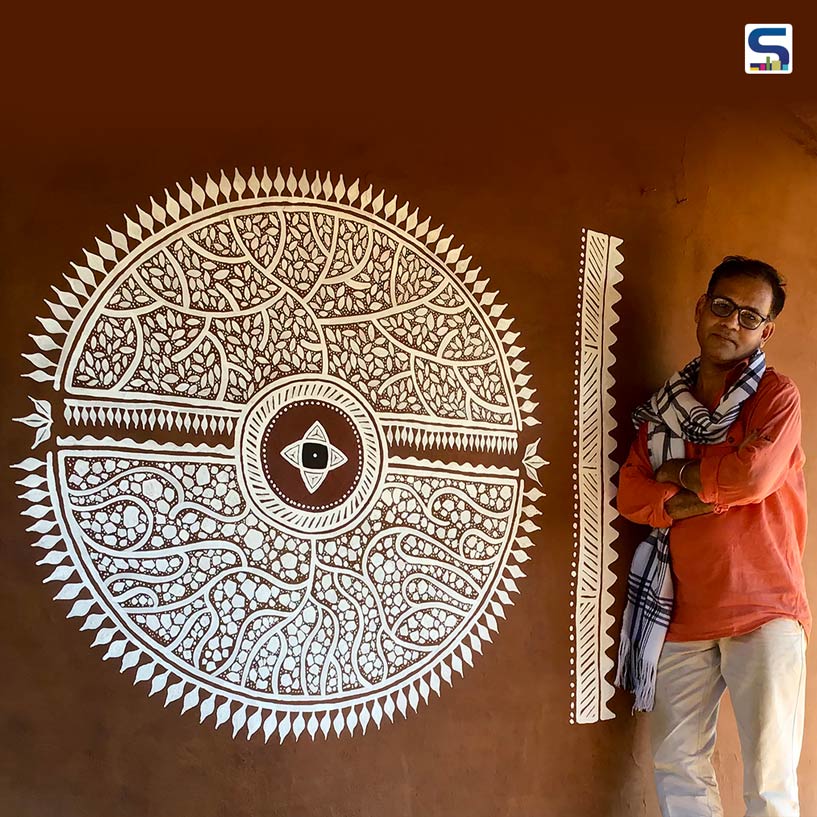
Mumbai based three-national award holder, senior research scholar, maestro of Mandana - ancient visual folk art, and multidisciplinary designer Lakhichand Jain has recently fashioned the interiors of a two-storey circular cob house, built using straw (dried grass), local soil, clay, cow dung, and lime. The art virtuoso has given a new meaning to this house using ancient Indian visual art—Mandana—in both folk and contemporary styles. The eminent visual artist shares with SURFACES REPORTER (SR) interesting details about the interior and spatial design work of this earthen mud house. Scroll down to read:
Also Read: Meet This Professor Who Makes Carbon-Negative Houses Using Cow Dung Plaster and Gaucrete | Haryana | SR Exclusive
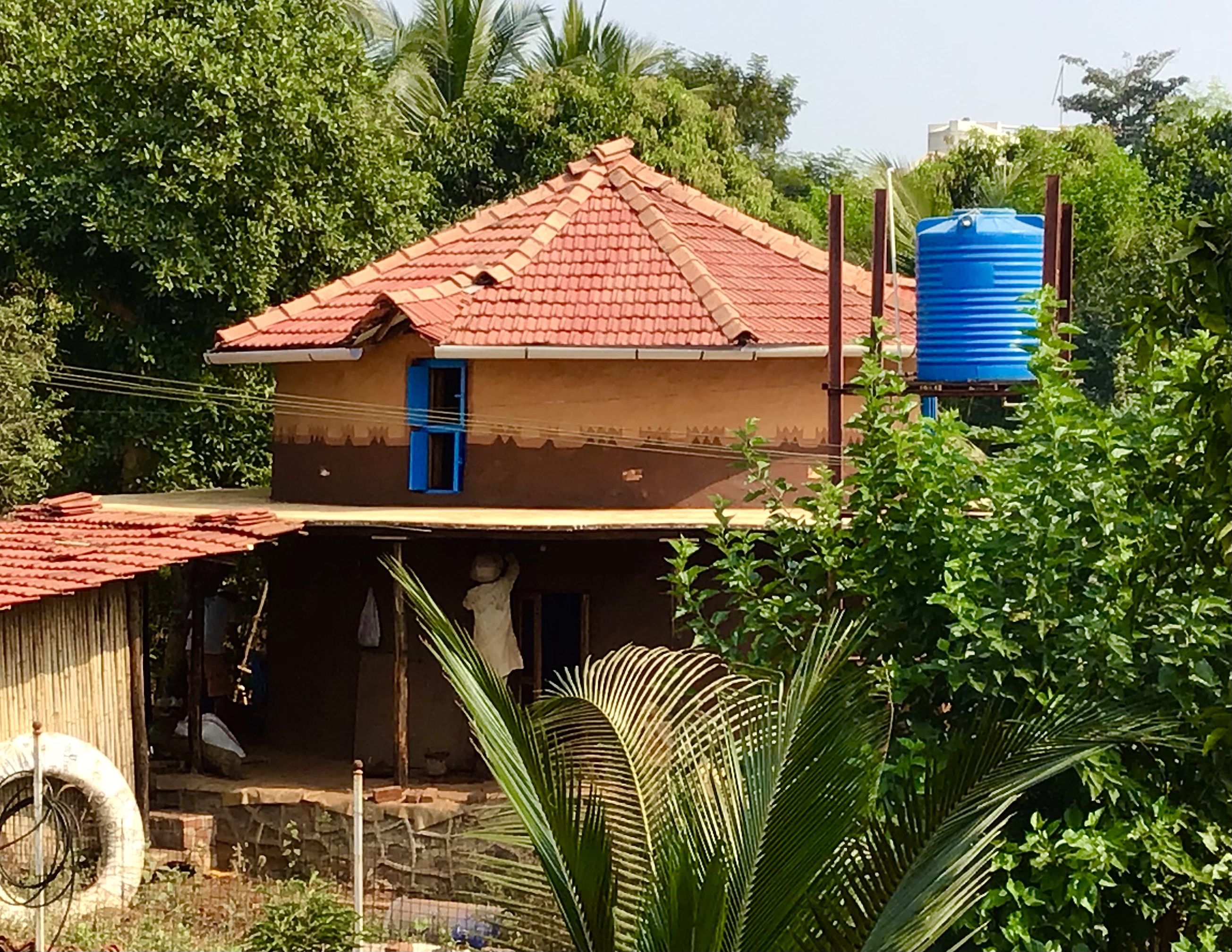 In this modern world, there are many avid people who detach themselves from the noise and chaos of urban life and the virtual world, adopt the loneliness of nature, and live with it by making natural shelters around it, also making their lives sustainable. Here, not only is Mother Nature nurturing them, but they are also nurturing their inner beings!
In this modern world, there are many avid people who detach themselves from the noise and chaos of urban life and the virtual world, adopt the loneliness of nature, and live with it by making natural shelters around it, also making their lives sustainable. Here, not only is Mother Nature nurturing them, but they are also nurturing their inner beings!
A Hybrid Cob house In the Lap of Nature
Recently, Prakash and Kiran Amati, a father-son duo, built a two-story, circular, hybrid cob house in the midst of nature, at Badlapur, just about 60 km away from the Mumbai metropolis. Before creating this circular cob house, both had attended a training programme on natural building at Geeli-Mitti' in Nainital. It is built using straw (dried grass), local soil, clay, cow dung, and lime, and using ancient Indian visual art—Mandana—in both folk and contemporary styles.
Beautification of Interior Spaces
Lakhichand Jain, who is an expert and conceptual designer of sustainable natural shelter, joined this project after the house was completed and dried well.
 Earlier, this mud house was completely empty and hollow on the inside. Under this, many spaces have been created during the beautification of this house.
Earlier, this mud house was completely empty and hollow on the inside. Under this, many spaces have been created during the beautification of this house.
 Due to the very small, old-style doors and windows in this house when it was empty, there was pitch darkness in the house even during the day. Also, the soil used to build this house was of a dark radish brown colour, due to which the light coming into the house from the walls of this house could not be reflected.
Due to the very small, old-style doors and windows in this house when it was empty, there was pitch darkness in the house even during the day. Also, the soil used to build this house was of a dark radish brown colour, due to which the light coming into the house from the walls of this house could not be reflected.
Muted Palette for Bright Interiors
Lakhichand is conscious art therapist, so he first used such colour shades for this house so that the walls could reflect the light coming into the house. “They told us that as my work progressed. The light natural colour used for the walls of this house has increased the level of light entering the house,’ says Lakhichand.
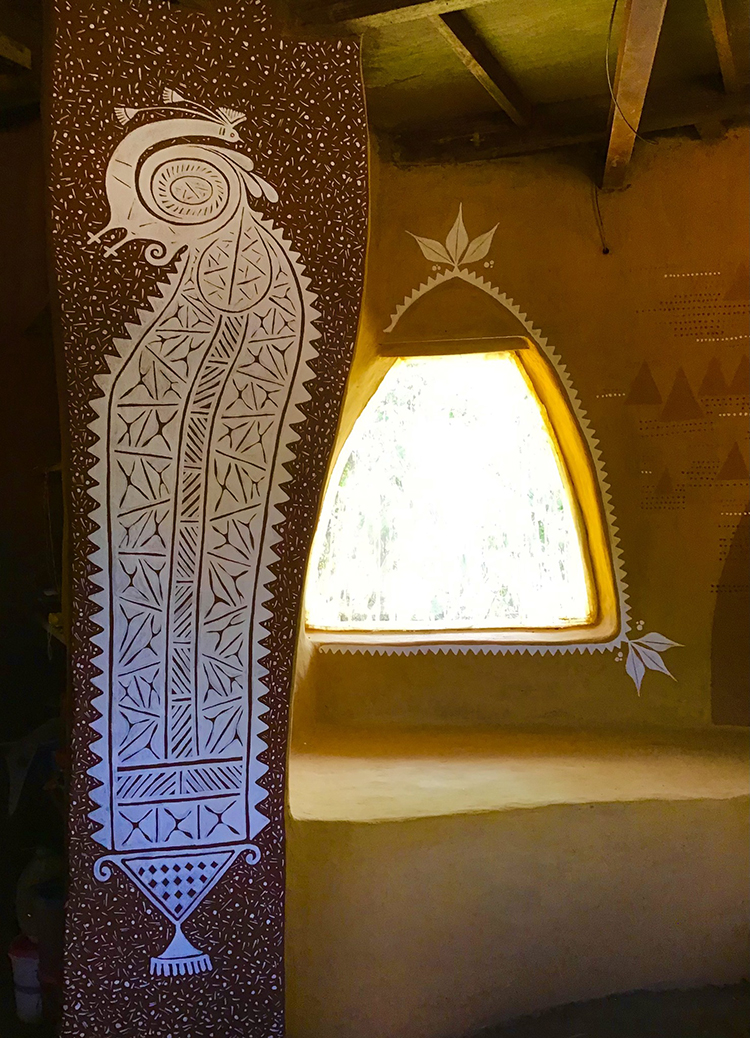 This house took on new life in a way. Along with this, the hidden natural energy of this house continued to emerge. Light started spreading instead of darkness.
This house took on new life in a way. Along with this, the hidden natural energy of this house continued to emerge. Light started spreading instead of darkness.
Spiritual Study Area
Here, the top floor room has been developed as a spiritual study room. The walls of the inner spaces are crafted by bas-relief clay work with a mixture of local clay, cow dung, and dried grass to depict 'the Tantra of inner awakening', and these tantra motifs have been embellished by the Indian folk art of Mandana.
Shakti has been brilliantly depicted in her symbolic form here, and each motif has its own story. These motifs have various tantric and spiritual meanings. Here, you can experience the peace that you are looking for.
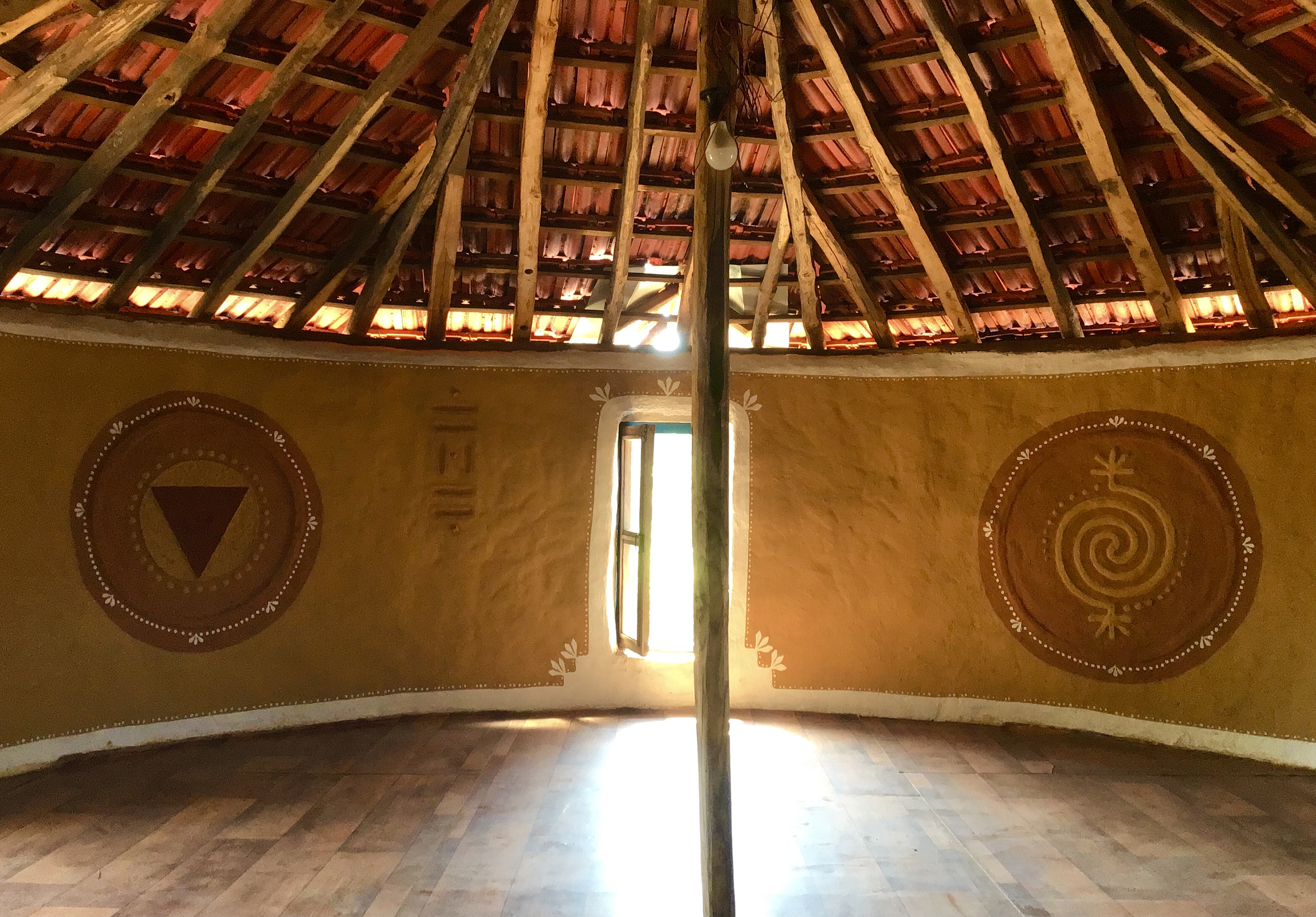 Colours bring us comfort, as well as the richness and hidden spirituality of natural colours. She inspires you to connect with your meditation. The entire exterior and interior walls of this house are painted with natural colours, and all the spaces are embellished with decorative forms.
Colours bring us comfort, as well as the richness and hidden spirituality of natural colours. She inspires you to connect with your meditation. The entire exterior and interior walls of this house are painted with natural colours, and all the spaces are embellished with decorative forms.
Lakhichand explains about motifs in circular form that, according to the 'Samkhya' philosophy, this world is shaped by the 'Samprayogikam' of Purusha and Prakriti, that is, the union of masculine and feminine energy. The motif of the spiritual study room is inspired by this concept. Here, nature is in the form of 'Shakti' (creative as well as feminine energy), and the circular form represents nature, wholeness, the universe.
Sky and Earth Meets On The Ground Floor
On the ground floor of this house, the elements of sky and earth are shown symbolically on the inner walls. On the right side of the entrance, the outer circular wall is adorned with the visual manifestation called 'Tree of Life' in bright white, and on the left side of the entrance, the wall embellishment tells the story of the destruction of nature through the visual arts in a folk style.
"Last year, Nov and Dec 2022, many such young volunteers from different places like Nepal, Singapore, North and South India, Mumbai, and Pune came together in Badlapur to understand the process of adding the finishing touches to cob houses, and they contributed their hands-on skills to complete the rest of the incomplete work," shares Lakhichand.
Lakhichand elaborates, “a natural mud or cob house has many qualities; it remains warm in the winter and cool in the summer. Natural mitti-colours are used for their interior and exterior wall spaces so that they can breathe.”
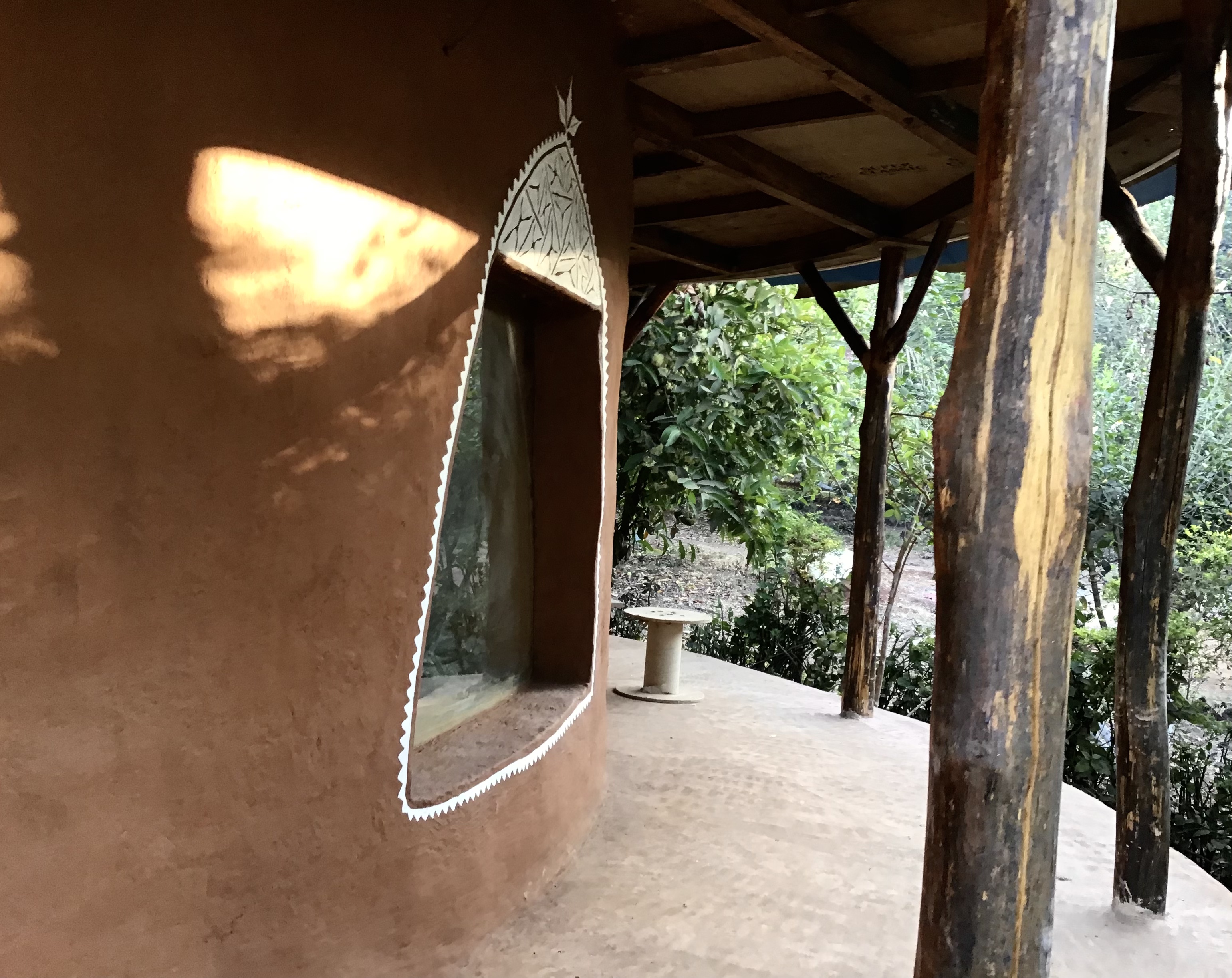 “Earlier, our village folk life was associated with mud houses. Then the houses were repaired from time to time, especially on festivals of light and auspicious celebrations. We have had two concepts about houses here, in ancient Hindu beliefs and earlier rural folk life. One is pucca (pure), and the other is kaccha (impure). It is believed that pucca houses are less likely to transmit negative energy. They are always antimicrobial because they are easily cleaned. But here, human beings carry negative energy in many ways. On the other hand, kuccha houses are made of local mud, and the elements contained in them fill the air and keep on taking in negative energy while breathing, due to which they are more likely to get infected. These cannot be easily cleaned like pucca houses,” he further adds.
“Earlier, our village folk life was associated with mud houses. Then the houses were repaired from time to time, especially on festivals of light and auspicious celebrations. We have had two concepts about houses here, in ancient Hindu beliefs and earlier rural folk life. One is pucca (pure), and the other is kaccha (impure). It is believed that pucca houses are less likely to transmit negative energy. They are always antimicrobial because they are easily cleaned. But here, human beings carry negative energy in many ways. On the other hand, kuccha houses are made of local mud, and the elements contained in them fill the air and keep on taking in negative energy while breathing, due to which they are more likely to get infected. These cannot be easily cleaned like pucca houses,” he further adds.
“As a result, in rural folk life, mud houses are occasionally smeared with cow dung, they are regularly maintained, and natural colours are used to decorate them. Cow dung contains antimicrobial elements, due to which these houses are safe from getting infected. In earlier folk life, the outer walls of mud houses and courtyards were symbolically painted with white khadiya to prevent the evil eye (negative energy) from entering. It is called Mandana in Rajasthan and is believed to act as a tabeej (protective shield). In Indian philosophy, the manifestation of ephemeral arts on the walls of the earthen house and courtyard is considered a symbol of positive divine energies,” he continues.
Mandana- An art that has several hidden healing qualities
Lakhichand is a maestro of Mandana; he says that the umbilical cord of Mandana is closely associated with the 'Alekhyam' of the Vedic period. It is one of the 64 arts described in the Kama Sutra, written by Vatsyayan. It is only an Indian art that has many hidden healing qualities. By discovering them, Lakhichand has expanded the Mandana as a 'conscious art.' He adds that this Indic art has ability to heal us and create a bridge between the material world and the inner subtle world. And of course, when you connect with this art consciously, it gives us a new mental strength.
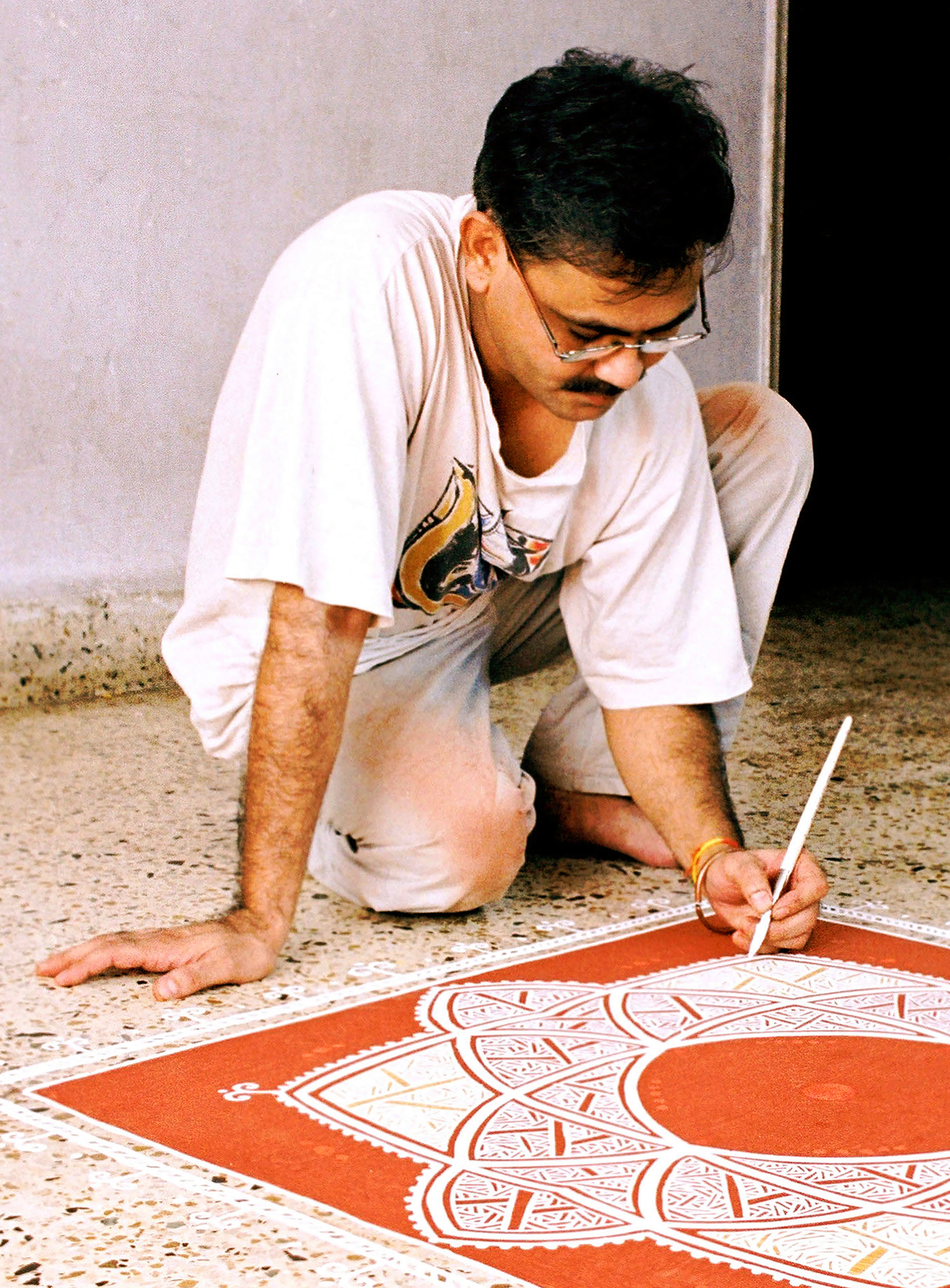 Lakhichand says that in recent times, due to increasing urbanisation and air pollution, the concept of moving away from city life, getting closer to Mother Nature, and building natural homes is rapidly taking shape in humans’ sensitive minds and is now becoming a part of the ecology movement.
Lakhichand says that in recent times, due to increasing urbanisation and air pollution, the concept of moving away from city life, getting closer to Mother Nature, and building natural homes is rapidly taking shape in humans’ sensitive minds and is now becoming a part of the ecology movement.
“We have very few people working in the field of making natural houses. So, people who want to build natural houses themselves are attending workshops on this topic in large numbers. In India, Thannal, Geeli Mitti, and a few others conduct workshops on many topics related to natural home construction,” he points out.
“Earlier, mud houses were usually very simple in terms of design, but now our needs have increased. So, while building a house, many things have to be included in it. New ideas are emerging in this field as well. As a result, we sometimes have to adopt too many unnatural materials to bring these ideas to life. Let's say I call these houses "hybrid mud houses."
Currently, Lakhichand's art and space design work for this circular cob house is being discussed in various groups related to natural house building on Facebook. He is also getting offers. A recipient of three national awards, Lakhichand was awarded a 'Senior Fellowship' from the Ministry of Culture (Govt. of India) last year. He is currently engaged in research work under a fellowship program. "At present, apart from research studies, I cannot think of any other assignment," says Lakhichand.
The importance of the presence of art in earthen homes
Since ancient times, houses made of clay and courtyards have been of great importance in Indian folklife. Just as 'a tiny sperm' develops into the form of a human being in a feminine womb and eventually becomes a part of this beautiful universe, similarly, in Indian culture, for a human being, his house is like a kind of womb.
From his birth until later in his life, he is cultured in the courtyard and in his home, becoming a part of the world of 'Maaya' (illusion). Then he continues his journey through life through the stages of adolescence, youth, adulthood, and old age. Throughout these stages, he remains in some way tied up to the house and courtyard until departing this world. In the beginning, man used to spend most of his time in the courtyard and his house, and that was the safest place for him. He was conscious of the health of his house and took care of its maintenance. From time to time, he used to repair the walls and courtyard.
Apart from this, in Indian folk life, there has been a deep connection between the courtyards, houses made of natural materials, and the decorative and symbolic visual expressions embellished on them.
And the presence of these visual manifestations (art) in the house is to be considered an auspicious symbol. Various types of floor and wall painting traditions can be found here and are made using natural colours.
Even today in India, most of the mud houses are smeared with cow dung or painted with natural colours for house warming, festivals, and auspicious celebrations, and various types of traditional folk art are created on them.
Also, the courtyard is also coated with fresh cow dung. It is used to create folk designs. In fact, they add colour to not only the home but also the life of a human. Most of the women in India take care of their earthen mud houses. They have a deep love for their homes.
The walls and courtyard of these houses are like canvases on which they express themselves through art. And since ancient times, she has nurtured these wall and floor arts as traditions. It was earlier used as 'sacred art therapy' in folk life.
When we live in these beautifully decorated earthen houses, we feel healed. The presence of colour and folk design infuses a unique energy into the homes, and it also makes the house environment blissful. Indirectly, it helps us stay stress-free.
In Indian philosophy, the art of floor and wall painting has been considered a symbol of positivity and divine energy. According to the ancient text 'Vishnudharmottara Purana', the presence of art is to be considered the key source of Dharma (righteousness, moral values, duty), Artha (economic values, wealth), Kama (pleasure, desire), and Moksha (liberation).
Input: Mandana.Bharti
About the Artist
Lakhichand Jain is a Kalwa (Thane) -based visual artist and multidisciplinary designer who creates bespoke bas-relief sculpture and design works in clay and cob in both traditional and contemporary styles. He studied visual communication and design at the MU University, Aurangabad (Maharashtra). And for the past 30 years, he has been associated with the field of design as a designer and design faculty. He has been bestowed with three national awards, including the nation’s highest youth felicitation - the National Youth Award (1990–91) by the Govt. of India. He is a senior fellow in the ancient Indic art of Mandana, and he has been awarded the prestigious Marudhara Samman (2016–17) and Sawai Jaipur Awards 2019 (the Raja Bhagwant Das award for excellence in traditional art). Also, he has been awarded the senior research fellowship by the Ministry of Culture (Govt. of India).
He is a revivalist of Mandana, and he has given new meaning and a new lease of life to this art. Around 15 years ago, India’s leading weekly magazine, "India Today," published a full-page story on his work in the ‘Offtrack’ column. He conducted many talk sessions for the fashion and accessory design, fashion communication, and fashion management students of NIFT as a guest faculty. For the past many years, he has been facilitating conscious art workshops and weekend retreats on Mandana and spirituality all across India. In 2018, he was invited to the live demonstration of Mandana at the 4th World Living Heritage Festival.
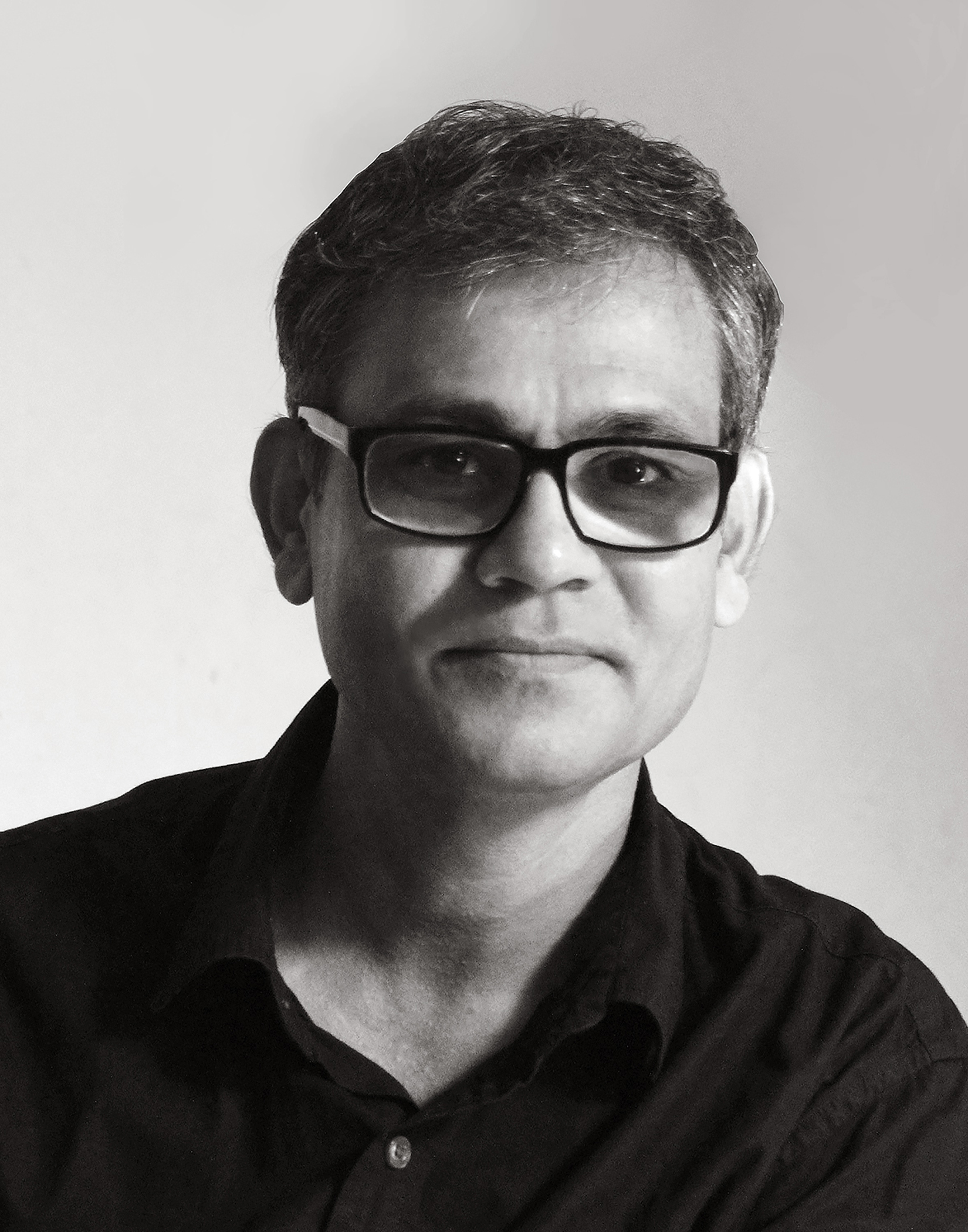
Keep reading SURFACES REPORTER for more such articles and stories.
Join us in SOCIAL MEDIA to stay updated
SR FACEBOOK | SR LINKEDIN | SR INSTAGRAM | SR YOUTUBE
Further, Subscribe to our magazine | Sign Up for the FREE Surfaces Reporter Magazine Newsletter
Also, check out Surfaces Reporter’s encouraging, exciting and educational WEBINARS here.
You may also like to read about:
This Man Used 2,500 Beer Bottles and Mud To Craft A Home in Just 6 Months With Just Rs 6 Lakhs | Kannur | Kerala
The Man Behind Worlds 1st Fully Automated Brick-Making Machine That Produces 300 Bricks a Minute | SR Interview
Gau-ghar- A Cow Shelter Made of Bamboo in Gujarat by Compartment S4
Made of Bamboo & Mud, Anandaloy by Ar Anna Heringer wins Obel award | Multifunctional structure | Bangladesh
And more…